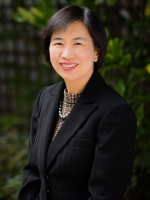USPSTF’s Proposed Breast Cancer Screening Guidelines prompt comments from UCSF Breast Imaging faculty Bonnie Joe, MD, PhD, and Kimberly Ray, MD

 On May 9, the U.S. Preventive Services Task Force (USPSTF) proposed a significant change to current breast cancer screening guidelines. The USPSTF’s draft proposal recommends lowering the recommended breast cancer screening age for average risk women to 40. Current USPSTF guidelines, in place since 2016, recommend starting biennial screening by age 50.
On May 9, the U.S. Preventive Services Task Force (USPSTF) proposed a significant change to current breast cancer screening guidelines. The USPSTF’s draft proposal recommends lowering the recommended breast cancer screening age for average risk women to 40. Current USPSTF guidelines, in place since 2016, recommend starting biennial screening by age 50.
The new recommendations are a positive step, but don’t go far enough, according to Bonnie Joe, MD, PhD, professor and chief of Breast Imaging at UCSF. “The goal of breast cancer screening is to reduce breast cancer deaths and morbidity - the adverse impact of the disease on the person. We should stick to that goal, and annual screening - not biennial – is the best way to meet this goal for those at average risk.”
A concern, says Dr. Joe, is the fact that USPSTF recommendations are tied to insurance coverage under the Affordable Care Act. Under the proposed guidelines, many people who want to be screened annually may lose coverage for yearly exams. “Those with more resources will still be able to afford to be screened every year while those with fewer resources may be screened less frequently, increasing their chance of their cancers not being diagnosed until they are at a more advanced stage.”
The draft also noted that beginning mammography screening at a younger age and screening more frequently may increase the risk for overdiagnosis (OD) and subsequent overtreatment. “Interval has no effect on OD,” counters Dr. Joe. “Tumors don’t go away, so a truly over-diagnosed cancer will still be there at the next mammogram – no matter whether it is one year or two years between exams.”
Kimberly Ray, MD, associate professor of clinical radiology at UCSF added that the USPSTF recommendations for biennial rather than annual screening will disproportionately affect minorities noting that one-third of all breast cancers in Black, Asian, and Hispanic women are diagnosed under age 50. She added that:
- Among all women with breast cancer, minority women are 72% more likely to be diagnosed with invasive breast cancer under age 50 years and 58% more likely to be diagnosed with advanced-stage disease under age of 50 years than non-Hispanic white women.
- Black women have 40% higher breast cancer mortality than non-Hispanic white women. Contributing factors include higher incidence of BRCA1 and BRCA2 mutations and twice the incidence of aggressive, triple-negative breast cancers in Black women. These cancers with aggressive biology tend to present at a younger age, more often before age 50.
Dr. Ray says that the above disparities can be reduced if more minorities are encouraged to undergo routine annual screening mammography. “Annual screening results in cancer detection at an earlier stage and fewer interval cancers (symptomatic cancers that present in between screening exams) than longer screening intervals. Diagnosing cancers at an earlier stage means that people will have better survival outcomes and may be spared the morbidity of more aggressive treatments."
Also potentially impacted by the proposed guidelines, Ray notes, are LGBTQ patients, who are less likely to present for cancer screening than non–LGBTQ patients. The American College of Radiology (ACR) recommends annual screening mammography beginning at age 40 for transfeminine (male-to-female) patients who have used hormones for ≥5 years, as well as for transmasculine (female-to-male) patients who have not had a mastectomy.
Finally, in addition to routine annual screening at age 40, the ACR now recommends that all women undergo breast cancer risk assessment at age 25. This will enable those women who are at elevated risk to undergo high risk screening beginning at age 25-30 with annual breast MRI in addition to mammography as well as to consider other risk reduction strategies.
USPSTF will take comments on the draft guidelines until June 5, 2023 at the USPSTF website.
